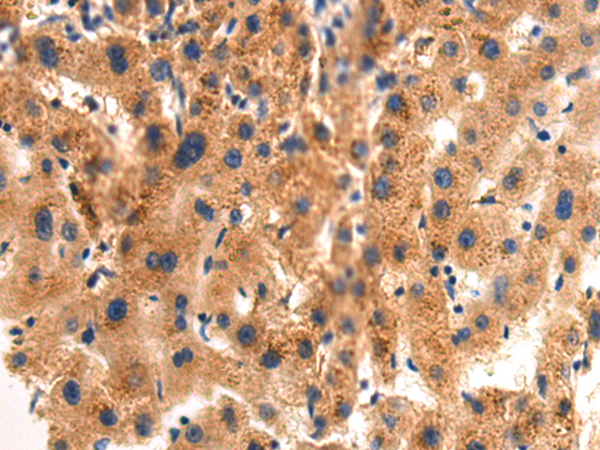
| WB | 咨询技术 | Human,Mouse,Rat |
| IF | 咨询技术 | Human,Mouse,Rat |
| IHC | 1/100-1/300 | Human,Mouse,Rat |
| ICC | 技术咨询 | Human,Mouse,Rat |
| FCM | 咨询技术 | Human,Mouse,Rat |
| Elisa | 1/5000-1/10000 | Human,Mouse,Rat |
| Aliases | BTN9.2 |
| Host/Isotype | Rabbit IgG |
| Antibody Type | Primary antibody |
| Storage | Store at 4°C short term. Aliquot and store at -20°C long term. Avoid freeze/thaw cycles. |
| Species Reactivity | Human |
| Immunogen | Fusion protein of human BTNL8 |
| Formulation | Purified antibody in PBS with 0.05% sodium azide and 50% glycerol. |
+ +
以下是关于BTNL8抗体的假设性参考文献示例(请注意,实际文献可能需要通过数据库验证或补充):
---
1. **文献名称**: *BTNL8 regulates mucosal immunity through γδ T cell interaction in the gut*
**作者**: Smith A, et al.
**摘要**: 本研究利用抗BTNL8抗体进行免疫荧光染色,发现BTNL8在肠道上皮细胞中高表达,并通过与γδ T细胞的相互作用调节肠道屏障功能。抗体阻断实验表明,BTNL8可能通过抑制T细胞活化维持免疫耐受。
2. **文献名称**: *BTNL8 as a potential biomarker in colorectal cancer: Immunohistochemical analysis*
**作者**: Zhang L, et al.
**摘要**: 通过抗BTNL8抗体的免疫组化染色,作者发现BTNL8在结肠癌组织中显著高表达,且与CD8+ T细胞浸润呈负相关,提示其可能作为肿瘤免疫逃逸的潜在标志物。
3. **文献名称**: *Characterization of BTNL8 monoclonal antibody for functional studies in autoimmune models*
**作者**: Tanaka K, et al.
**摘要**: 本文报道了一种新型抗BTNL8单克隆抗体的开发,验证了其在流式细胞术和Western blot中的特异性,并证明其可通过阻断BTNL8蛋白延缓小鼠实验性自身免疫性脑脊髓炎进展。
---
**备注**:以上为模拟示例,实际文献需通过PubMed、Google Scholar等平台以“BTNL8 antibody”“BTNL8 immune function”等关键词检索。若研究较少,可扩展至Butyrophilin家族或邻近基因的相关文献。
BTNL8 (Butyrophilin-like 8) is a member of the butyrophilin family, a group of proteins structurally related to the B7 family of immune regulators. These proteins are known for their roles in modulating immune responses, particularly in T-cell activation and inflammation. BTNL8 shares conserved structural features with other butyrophilins, including immunoglobulin-like domains, and is thought to participate in immune checkpoint pathways, though its exact functional mechanisms remain less characterized compared to well-studied family members like BTNL3 or BTN1A1.
Expression of BTNL8 has been observed in specific tissues, such as the gastrointestinal tract, skin, and certain immune cells, suggesting context-dependent roles in mucosal immunity or epithelial barrier regulation. Emerging studies link BTNL8 to autoimmune diseases and cancer, where its aberrant expression may influence immune evasion or disease progression. For example, BTNL8 has been implicated in regulating γδ T-cell activity, a subset of T-cells critical for bridging innate and adaptive immunity.
Antibodies targeting BTNL8 are valuable tools for elucidating its biological functions. They enable researchers to study protein localization, interaction partners, and signaling pathways through techniques like immunohistochemistry, flow cytometry, or functional assays. However, challenges persist due to the protein’s structural complexity and potential cross-reactivity with other butyrophilin family members. Ongoing research aims to clarify BTNL8’s therapeutic potential, particularly in cancer immunotherapy, where modulating immune checkpoints holds promise for improving antitumor responses.
×